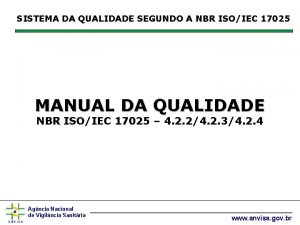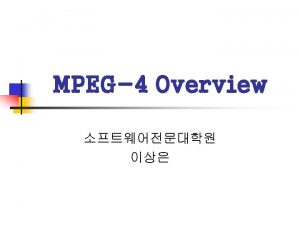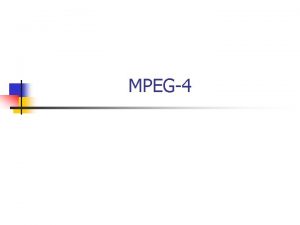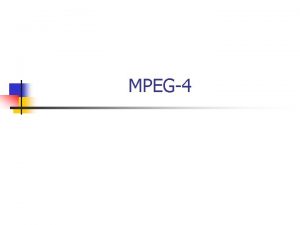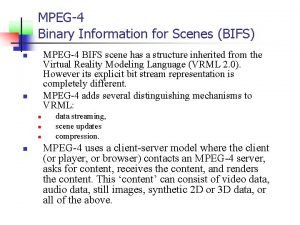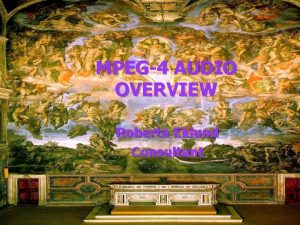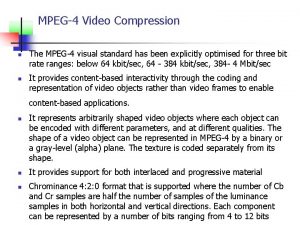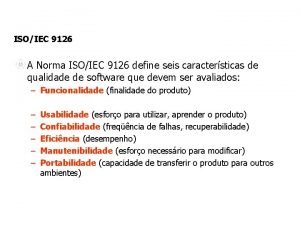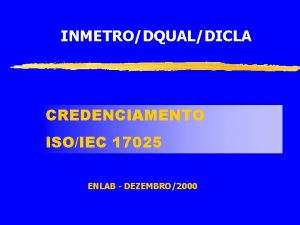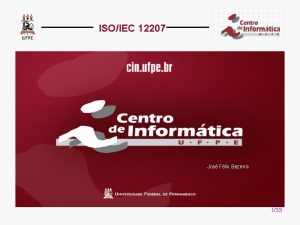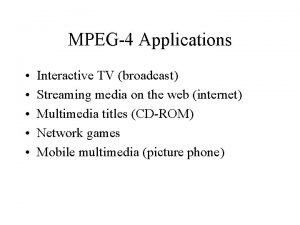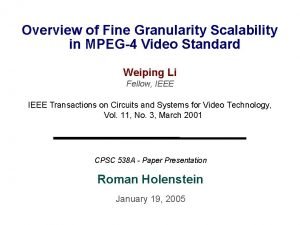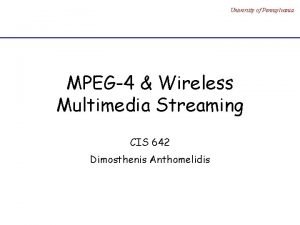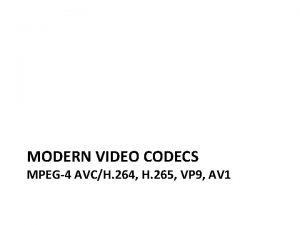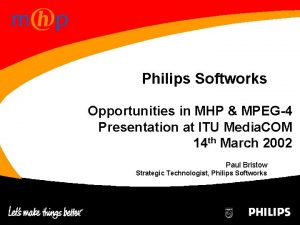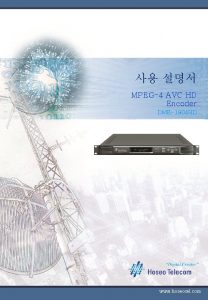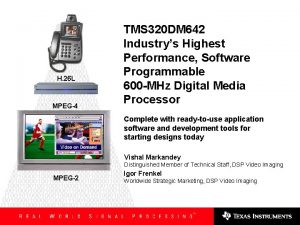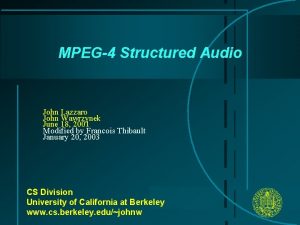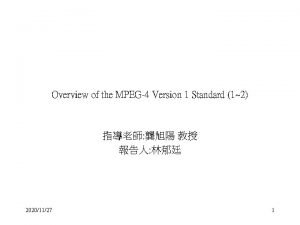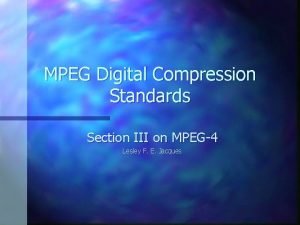MPEG4 MPEG4 n n n MPEG4 or ISOIEC









































































- Slides: 73

MPEG-4

MPEG-4 n n n MPEG-4, or ISO/IEC 14496 is an international standard describing coding of audio-video objects the 1 st version of MPEG-4 became an international standard in 1999 and the 2 nd version in 2000 (6 parts); since then many parts were added and some are under development today MPEG-4 included object-based audio-video coding for Internet streaming, television broadcasting, but also digital storage MPEG-4 included interactivity and VRML support for 3 D rendering has profiles and levels like MPEG-2 has 27 parts

MPEG-4 parts n n n n Part 1, Systems – synchronizing and multiplexing audio and video Part 2, Visual – coding visual data Part 3, Audio – coding audio data, enhancements to Advanced Audio Coding and new techniques Part 4, Conformance testing Part 5, Reference software Part 6, DMIF (Delivery Multimedia Integration Framework) Part 7, optimized reference software for coding audiovideo objects Part 8, carry MPEG-4 content on IP networks

MPEG-4 parts (2) n n n Part 9, reference hardware implementation Part 10, Advanced Video Coding (AVC) Part 11, Scene description and application engine; BIFS (Binary Format for Scene) and XMT (Extensible MPEG-4 Textual format) Part 12, ISO base media file format Part 13, IPMP extensions Part 14, MP 4 file format, version 2 Part 15, AVC (advanced Video Coding) file format Part 16, Animation Framework e. Xtension (AFX) Part 17, timed text subtitle format Part 18, font compression and streaming Part 19, synthesized texture stream

MPEG-4 parts (3) n n n n Part 20, Lightweight Application Scene Representation (LASe. R) and Simple Aggregation Format (SAF) Part 21, MPEG-J Graphics Framework e. Xtension (GFX) Part 22, Open Font Format Part 23, Symbolic Music Representation Part 24, audio and systems interaction Part 25, 3 D Graphics Compression Model Part 26, audio conformance Part 27, 3 D graphics conformance

Motivations for MPEG-4 n Broad support for MM facilities are available n n Incompatible content formats n n n n 2 D and 3 D graphics, audio and video – but 3 D graphics formats as VRML are badly integrated to 2 D formats as FLASH or HTML Broadcast formats (MHEG) are not well suited for the Internet Some formats have a binary representation – not all SMIL, HTML+, etc. solve only a part of the problems Both authoring and delivery are cumbersome Bad support for multiple formats

MPEG-4: Audio/Visual (A/V) Objects n Simple video coding (MPEG-1 and – 2) n n n Object-based video coding (MPEG-4) n n n A/V information is represented as a sequence of rectangular frames: Television paradigm Future: Web paradigm, Game paradigm … ? A/V information: set of related stream objects Individual objects are encoded as needed Temporal and spatial composition to complex scenes Integration of text, “natural” and synthetic A/V A step towards semantic representation of A/V Communication + Computing + Film (TV…)

Main parts of MPEG-4 1. Systems – Scene description, multiplexing, synchronization, buffer management, intellectual property and protection management 2. Visual – Coded representation of natural and synthetic visual objects 3. Audio – Coded representation of natural and synthetic audio objects 4. Conformance Testing – Conformance conditions for bit streams and devices 5. Reference Software – Normative and non-normative tools to validate the standard 6. Delivery Multimedia Integration Framework (DMIF) – Generic session protocol for multimedia streaming

Main objectives – rich data n Efficient representation for many data types n Video from very low bit rates to very high quality n n Music and speech data for a very wide bit rate range n n n n Very low bit rate speech (1. 2 – 2 Kbps). . Music (6 – 64 Kbps). . Stereo broadcast quality (128 Kbps) Synthetic objects n n 24 Kbs. . several Mbps (HDTV) Generic dynamic 2 D and 3 D objects Specific 2 D and 3 D objects e. g. human faces and bodies Speech and music can be synthesized by the decoder Text Graphics

Main objectives – robust + pervasive n Resilience to residual errors n n Platform independence Transport independence n n n Provided by the encoding layer Even under difficult channel conditions – e. g. mobile MPEG-2 Transport Stream for digital TV RTP for Internet applications DAB (Digital Audio Broadcast). . . However, tight synchronization of media Intellectual property management + protection n For both A/V contents and algorithms

Main objectives - scalability n Scalability n n Enables partial decoding Audio - Scalable sound rendering quality Video - Progressive transmission of different quality levels - Spatial and temporal resolution Profiling n n Enables partial decoding Solutions for different settings Applications may use a small portion of the standard “Specify minimum for maximum usability”

Main objectives - genericity n n n n Independent representation of objects in a scene Independent access for their manipulation and re-use Composition of natural and synthetic A/V objects into one audiovisual scene Description of the objects and the events in a scene Capabilities for interaction and hyper linking Delivery media independent representation format Transparent communication between different delivery environments

Object-based architecture

MPEG-4 as a tool box n n n n MPEG-4 is a tool box (no monolithic standard) Main issue is not a better compression No “killer” application (as DTV for MPEG-2) Many new, different applications are possible Enriched broadcasting, remote surveillance, games, mobile multimedia, virtual environments etc. Profiles Binary Interchange Format for Scenes (BIFS) n n n Based on VRML 2. 0 for 3 D objects “Programmable” scenes Efficient communication format

MPEG-4 Systems part

MPEG-4 scene, VRML-like model

Logical scene structure

MPEG-4 Terminal Components

Digital Terminal Architecture

BIFS tools – scene features n n n 3 D, 2 D scene graph (hierarchical structure) 3 D, 2 D objects (meshes, spheres, cones etc. ) 3 D and 2 D Composition, mixing 2 D and 3 D Sound composition – e. g. mixing, “new instruments”, special effects Scalability and scene control n n Terminal capabilities (Term. Cab) MPEG-J for terminal control Face and body animation XMT - Textual format; a bridge to the Web world

BIFS tools – command protocol n Replace a scene with this new scene n n n Insert node in a grouping node n n A replace command is an entry point like an I-frame The whole context is set to the new value Instead of replacing a whole scene, just adds a node Enables progressive downloads of a scene Delete node - deletion of an element costs a few bytes Change a field value; e. g. color, position, switch on/off an object

BIFS tools – animation protocol n n n The BIFS Command Protocol is a synchronized, but non streaming media Anim is for continuous animation of scenes Modification of any value in the scene – Viewpoints, transforms, colors, lights The animation stream only contains the animation values Differential coding – extremely efficient

Elementary stream management n Object description n n Relations between streams and to the scene Auxiliary streams: n n n IPMP – Intellectual Property Management and Protection OCI – Object Content Information Synchronization + packetization – Time stamps, access unit identification, … System Decoder Model File format - a way to exchange MPEG-4 presentations

An example MPEG-4 scene

Object-based compression and delivery

Linking streams into the scene (1)

Linking streams into the scene (2)

Linking streams into the scene (3)

Linking streams into the scene (4)

Linking streams into the scene (5)

Linking streams into the scene (6) n An object descriptor contains ES descriptors pointing to: n n n Scalable coded content streams Alternate quality content streams Object content information IPMP information terminal may select suitable streams ES descriptors have subdescriptors to: n n Decoder configuration (stream type, header) Sync layer configuration (for flexible SL syntax) Quality of service information (for heterogeneous nets) Future / private extensions

Describing scalable content

Describing alternate content versions

Decoder configuration info in older standards cfg = configuration information (“stream headers”)

Decoder configuration information in MPEG-4 • the OD (ESD) must be retrieved first • for broadcast ODs must be repeated periodically

The Initial Object Descriptor n n n Derived from the generic object descriptor – Contains additional elements to signal profile and level (P&L) P&L indications are the default way of content selection – The terminal reads the P&L indications and knows whether it has the capability to process the presentation Profiles are signaled in multiple separate dimensions n n n Scene description Graphics Object descriptors Audio Visual The “first” object descriptor for an MPEG-4 presentation is always an initial object descriptor

Transport of object descriptors n Object descriptors are encapsulated in OD commands – Object. Descriptor. Update / Object. Descriptor. Remove – ES_Descriptor. Update / ES_Descriptor. Remove n OD commands are conveyed in their own object descriptor stream in a synchronized manner with time stamps – Objects / streams may be announced during a presentation n There may be multiple OD & scene description streams – A partitioning of a large scene becomes possible n Name scopes for identifiers (OD_ID, ES_ID) are defined – Resource management for sub scenes can be distributed n Resource management aspect - If the location of streams is changed, only the ODs need

Initial OD pointing to scene and OD stream

Initial OD pointing to a scalable scene

Auxiliary streams n IPMP streams n n n OCI (Object Content Information) streams n n n Information for Intellectual Property Management and Protection Structured in (time stamped) messages Content is defined by proprietary IPMP systems Complemented by IPMP descriptors Meta data for an object (“Poor man’s MPEG-7”) Structured descriptors conveyed in (time stamped) messages Content author, date, keywords, description, language, . . . Some OCI descriptors may be directly in ODs or ESDs ES_Descriptors pointing to such streams may be attached to any object descriptor – scopes the IPMP or OCI stream n An IPMP stream attached to the object descriptor stream is valid for all streams

Adding an OCI stream to an audio stream

Adding OCI descriptors to audio streams

Linking streams to a scene – including “upstreams”

MPEG-4 streams

Synchronization of multiple elementary streams n n Based on two well known concepts Clock references – Convey the speed of the encoder clock n Time stamps – Convey the time at which an event should happen n Time stamps and clock references are n n defined in the system decoder model conveyed on the sync layer

System Decoder Model (1)

System Decoder Model (2) n Ideal model of the decoder behavior – Instantaneous decoding – delay is implementation’s problem n Incorporates the timing model – Decoding & composition time n Manages decoder buffer resources n n n Useful for the encoder Ignores delivery jitter Designed for a rate-controlled “push” scenario – Applicable also to flow-controlled “pull” scenario n Defines composition memory (CM) behavior n n A random access memory to the current composition unit CM resource management not implemented

Synchronization of elementary streams with time events in the scene description n How are time events handled in the scene description? How is this related to time in the elementary streams? Which time base is valid for the scene description?

Cooperating entities in synchronization n n n Time line (“object time base”) for the scene Scene description stream with time stamped BIFS access units Object descriptor stream with pointers to all other streams Video stream with (decoding & composition) time stamps Audio stream with (decoding & composition) time stamp Alternate time line for audio and video

A/V scene with time bases and stamps

Hide the video at time T 1

Hide the video on frame boundary

The Synchronization Layer (SL) n Synchronization layer (short: sync layer or SL) n n Indicates boundaries of access units n n SL packet = one packet of data Consists of header and payload Defines a “wrapper syntax” for the atomic data: access unit Access. Unit. Start. Flag, Access. Unit. End. Flag, AULength Provides consistency checking for lost packets Carries object clock reference (OCR) stamps Carries decoding and composition time stamps (DTS, CTS)

Elementary Stream Interface (1)

Elementary Stream Interface (2)

Elementary Stream Interface (3)

Elementary Stream Interface (4)

The sync layer design n Access units are conveyed in SL packets Access units may use more than one SL packets have a header to encode the information conveyed through the ESI SL packets that don’t start an AU have a smaller header

How is the sync layer designed ? n As flexible as possible to be suitable for n n n Time stamps have n n n variable length variable resolution Same for clock reference (OCR) values n n a wide range of data rates a wide range of different media streams OCR may come via another stream Alternative to time stamps exists for lower bit rate n n Indication of start time and duration of units (access. Unit. Duration, composition. Unit. Duration)

SLConfig. Descriptor syntax example class SLConfig. Descriptor { uint (8) predefined; if (predefined==0) { bit(1) use. Access. Unit. Start. Flag; bit(1) use. Access. Unit. End. Flag; bit(1) use. Random. Access. Point. Flag; bit(1) use. Padding. Flag; bit(1) use. Time. Stamps. Flag; uint(32) time. Stamp. Resolution; uint(32) OCRResolution; uint(6) time. Stamp. Length; uint(6) OCRLength; if (!use. Time. Stamps) {. . . . SDLSyntax Description Language

Wrapping SL packets in a suitable layer

MPEG-4 Delivery Framework (DMIF)

The MPEG-4 Layers and DMIF n DMIF hides the delivery technology n n Compression Layer n n n Media aware Delivery unaware Sync Layer n n n Adopts Qo. S metrics Media unaware Delivery Layer n n Media unaware Delivery aware

DMIF communication architecture

Multiplex of elementary streams n n Not a core MPEG task Just respond to specific needs for MPEG-4 content transmission n n Low delay Low overhead Low complexity This prompted the design of the “Flex. Mux” tool One single file format desirable n This lead to the design of the MPEG-4 file format

Modes of Flex. Mux

How to configure Mux. Code mode ?

A multiplex example

Multiplexing audio channels in Flex. Mux

Multiplexing all channels to MPEG-2 TS

MPEG-2 Transport Stream

MPEG-4 content access procedure n n n Locate an MPEG-4 content item (e. g. by URL) and connect to it – Via the DMIF Application Interface (DAI) Retrieve the Initial Object Descriptor This Object Descriptor points to an BIFS + OD stream – Open these streams via DAI Scene Description points to other streams through Object Descriptors - Open the required streams via DAI Start playing!

MPEG-4 content access example
